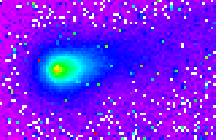The Hyakutake Comet
Click on image for full size
Michael Brown (University of Melbourne), Chris Fluke (University of Melbourne) and Mount Stromlo and Siding Spring Observatories
DISCOVERED! X-rays from comet Hyakutake
News story originally written on May 18, 1997
A bit of background
The solar wind coming from the Sun can steal electrons from atoms found in comets. These stolen electrons start off very excited (with lots of energy). Electrons can't stay in an excited state for very long. They get "tired" just like humans do. So they give off energy so they can become less excited. When the energy is given off, we can detect a x-ray. So by looking at x-rays, we can figure out where a comet is in space.
The details of the discovery
On March 27, 1996, observations were taken of the Comet Hyakutake by a German satellite. X-rays (the first from any comet) were detected at this time. Very powerful computers were then used to figure out the relationship of the x-rays to the location of the head of the comet.
This new theory of a comet's x-rays will be tested on the Comet Hale-Bopp using Japan's ASCA x-ray satellite in September.
You might also be interested in:

It was another exciting and frustrating year for the space science program. It seemed that every step forward led to one backwards. Either way, NASA led the way to a great century of discovery. Unfortunately,
...more
The Space Shuttle Discovery lifted off from Kennedy Space Center on October 29th at 2:19 p.m. EST. The weather was great as Discovery took 8 1/2 minutes to reach orbit. This was the United States' 123rd
...more
A moon was discovered orbiting the asteroid, Eugenia. This is only the second time in history that a satellite has been seen circling an asteroid. A special mirror allowed scientists to find the moon
...more
Will Russia ever put the service module for the International Space Station in space? NASA officials want an answer from the Russian government. The necessary service module is currently waiting to be
...more
A coronal mass ejection (CME) happened on the Sun early last month. The material that was thrown out from this explosion passed the ACE spacecraft. The SWICS instrument on ACE has produced a new and very
...more
J.S. Maini of the Canadian Forest Service called forests the "heart and lungs of the world." This is because forests filter air and water pollution, absorb carbon dioxide, release oxygen, and maintain
...more
In late April through mid-May 2002, all five naked-eye planets are visible at the same time in the night sky! This is includes Mercury which is generally very hard to see. You won't want to miss this!
...more















